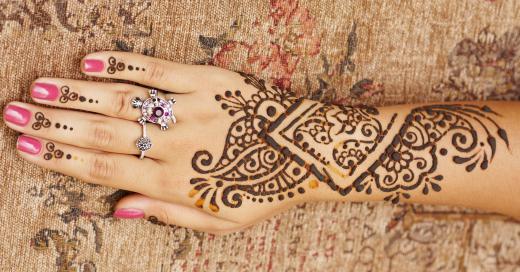When you make henna, you typically have several places to start. You may simply want to make henna paste with purchased powder. Some people may prefer starting from scratch by growing henna plants from seed. Growing your own plants means you can make henna from leaves you've harvested and dried yourself. The second method is usually a sure way to get fresh, chemical-free henna powder, but the first method may be less hassle.
Those who want to make henna from scratch, meaning starting with planting henna seeds, should note that henna plants must typically be houseplants if the artist is not living in India; very hot, humid climates are essential for henna plants to survive. Once planted in the proper conditions, the plants usually thrive without much help. All that's needed are three or four henna seeds pushed into moist, very rich soil.

Misting the soil daily and placing it in a warm room under a plastic greenhouse cone should provide good growing conditions. Greenhouse cones — clear plastic cones with a small hole at the tip — can be used to hold in warmth and moisture. When the henna plant has sprouted about three dozen large leaves, the henna artist may harvest about a third of these. Thick, large, dark green leaves generally work best when you make henna powder.

To dry henna leaves, simply lay them between paper towels and set them in a warm, dry place for about three weeks. The leaves should be pale green and very brittle when they're fully dry. The artist may then grind the leaves in a food processor, nut grinder, or with a mortar and pestle. If none of these are available, the artist may crumble them by hand, then crush the flakes into a fine powder with the tip of a wooden spoon. The powder should look like a mix between flour and sand.

Lemon juice is the first ingredient that goes into both homemade and commercial henna powder to make henna paste. It is followed closely by lavender and bergamot essential oils. The artist should mix the paste with a wooden or plastic spoon in a wooden or ceramic bowl, using enough lemon juice that the henna powder forms a thick, malleable paste. About 10 drops each of lavender and bergamot oils not only help the henna smell good, they also help the lemon juice pull dye from the henna, making tattoos darker.

Once mixed, the henna paste must be covered with plastic wrap and allowed to rest for 12 to 24 hours. This resting time allows the henna powder to oxidize and create the dark, reddish-orange dye traditional to henna tattoos. After oxidation, the artist may apply the henna to his or her skin, hair, or even clothing to create natural henna art.
